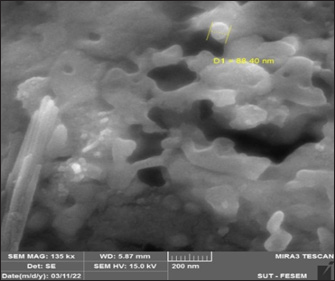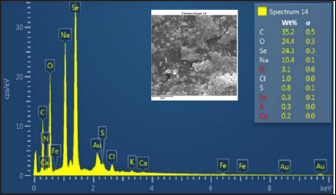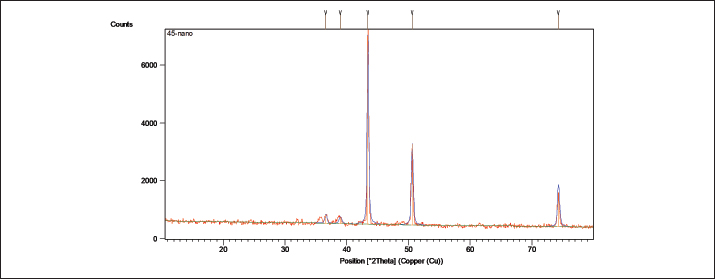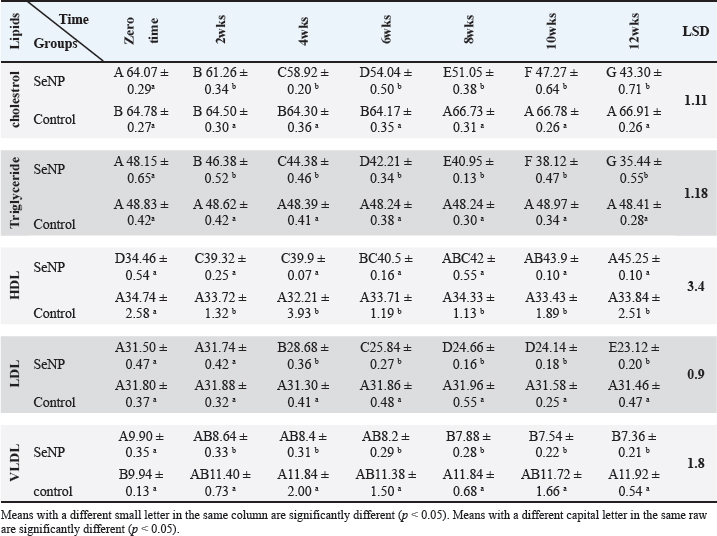
| Research Article | ||
Open Vet. J.. 2024; 14(5): 1161-1166 Open Veterinary Journal, (2024), Vol. 14(5): 1161–1166 Research Article Effect of selenium nanoparticle on lipid profile in local Awassi male lambsAseel Mohammed Hamzah1* and Tamara Natik Dawood21Zoonotic Disease Unit, College of Veterinary Medicine, Baghdad University, Baghdad, Iraq 2Department of Public Health, College of Veterinary Medicine, Baghdad University, Baghdad, Iraq *Corresponding Author: Aseel Mohammed Hamzah. Zoonotic Disease Unit, College of Veterinary Medicine, Baghdad University, Baghdad, Iraq. Email: arianidr [at] ub.ac.id; aseelm30 [at] covm.uobaghdad.edu.iq Submitted: 27/01/2024 Accepted: 22/04/2024 Published: 31/05/2024 © 2024 Open Veterinary Journal
AbstractBackground: This research describes the methodology used for the preparation of selenium nanoparticles from Pseudomonas aeruginosa and their administration to lambs for lipid profile checking, administration of selenium nanoparticles as a medication in lambs results in hypolipidemia. Aimed: The study aimed to investigate the potential of selenium nanoparticles in improving lipid profiles in lambs. Methods: Healthy lambs (n=10) of similar age and weight were selected for the study. The animals were housed in individual pens with free access to water and a standard diet. The lambs were randomly divided into two groups: the control group (n=5) and the treatment group (n=5). The control group received a standard diet, while the treatment group received the same diet and oral administrated with selenium nanoparticles at 0.1 mg/kg body weight. The administration was carried out daily for a period of 8 weeks. Blood samples were collected from the jugular vein of each lamb at the beginning of the study (baseline) and at the end of the 2 weeks treatment period. The samples were collected in vacutainer tubes and allowed to clot. Serum was separated by centrifugation at 3,000 rpm for 10 minutes and stored at −80°C for estimation of lipid profile total cholesterol (TC), triglyceride, high-density lipoprotein (HDL), and low-density lipoprotein (LDL). The serum samples were used for the estimation of lipid profile levels using an enzymatic colorimetric method. The absorbance was measured at 540 nm using a spectrophotometer. Results: The results showed a significant decrease in serum TC, triglyceride, and very-low-density lipoprotein cholesterol levels after selenium nanoparticle supplementation compared to the control group (p < 0.05), the results indicated a significant increase in serum HDL levels after selenium nanoparticle supplementation compared to the control group (p < 0.05). This indicates that selenium nanoparticle supplementation has a beneficial effect on reducing TC levels in lambs. Conclusion: The conclusion section will summarize the findings of the study and highlight the potential of selenium nanoparticles in improving lipid profiles in lambs. The implications of the study for animal nutrition and health will be discussed, along with the need for further research in this area. Keywords: Selenium nanoparticles, Lipid profile, Lambs. IntroductionConsidering the lipid profile of an animal is crucial when assessing its overall well-being (Ponnampalam et al., 2022). It is important to comprehend the impact of specific substances, such as selenium nanoparticles, on the lipid profile of local Awassi male lambs (Ozturk Kurt and Ozdemir, 2022, Al-Janabi et al., 2023). As a trace element, selenium is essential for numerous physiological functions and has been found to confer several health benefits to animals (Aljaf and Bolshakova, 2023). Numerous studies have indicated that selenium nanoparticles have a positive impact on the blood lipid levels of local Awassi male lambs when administered. It is known that these nanoparticles augment the effectiveness of glutathione peroxidase, an enzyme that shields cells against oxidative harm (Wali et al., 2019; Bokharaeian et al., 2023). Reducing the number of free radicals in the body can enhance heart health by lowering total cholesterol (TC), low-density lipoprotein (LDL) cholesterol, and triglyceride levels. Animal research has shown that high levels of these lipids are associated with a higher likelihood of developing cardiovascular diseases (Mohammadifard et al., 2022). Biosynthesizing nanoparticles with desired morphology (form, size, and crystalline nature) is a key aim in chemistry. These nanoparticles may be employed for many applications such as catalysis, biomedicine, cheaper electrodes, and biosensors. Nanoparticles have unique chemical and physical properties and serve as a connection between bulk materials and their molecular or atomic structure and uses in many fields (Alhagiesa and Ghareeb, 2021; Ali and Karem, 2024; Musa et al., 2024;). It was shown that vitamin E and selenium are vital antioxidants and that the sheep business can suffer significant losses if these nutrients aren't present (Abood, 2012; Judi, 2013). Selenium nanoparticles have been studied for how they change the fat levels in local Awassi male lambs. Research has shown different results. The available studies show that giving nano-selenium as a nutritional supplement changed the lipid profile, of male lambs, including a drop in cholesterol levels (Aljaf and Bolshakova, 2023). This indicates a potential role for nano-selenium in modulating the lipid metabolism in these animals. A study showed that giving small doses of selenium and vitamin D3 to Awassi sheep lowered their TC, triglycerides (TG), and low-density lipoprotein (LDL). Meanwhile, it increased high-density ones which have a beneficial role (Al-Janabi et al., 2023). A different study found that adding selenium, with or without vitamin E to lambs’ food greatly improved their final body weight, daily weight gain, and levels of thyroxin and growth hormone (Dhari and Kassim, 2019). A study that used a yeast (Saccharomyces cerevisiae) enriched with zinc and selenium found big differences in levels of triglyceride, LDL, very-low-density lipoprotein cholesterol (VLDL), and HDL between the control group and the treated one. Additionally, dietary supplementation of nano selenium had an effect on blood lipid levels including HDL, LDL, T4, T3, and glutathione peroxidase, according to research conducted on male Moghani lambs (Ghaderzadeh et al., 2019; Titov et al., 2022). Many studies have revealed that ruminants get their necessary amounts of minerals, such as selenium, from plants (Mehdi and Dufrasne, 2016). The Awassi breed of sheep is widely distributed in the Middle East and Mediterranean regions. These lambs are highly valued for their meat quality and adaptability to harsh environmental conditions. However, there is limited research on the effect of selenium nanoparticle supplementation on the lipid profile of local Awassi male lambs. The objective of this study is to evaluate the effect of selenium nanoparticle supplementation on the lipid profile of local Awassi male lambs. We hypothesize that selenium nanoparticle supplementation will positively influence the lipid profile of these lambs, leading to improved lipid metabolism and potentially reducing the risk of cardiovascular diseases and metabolic disorders. Material and MethodsBacterial culturingTo initiate bacterial culturing, a loopful of the Pseudomonas aeruginosa culture plate was inoculated into 250 ml of sterile nutrient broth (NB). The mixture was then incubated at a temperature of 37°C for a duration of 24 hours. Subsequently, the cells were extracted through centrifugation at a speed of 6,000 rpm for a duration of 10 minutes. The resulting supernatant was collected and transferred to a separate 250 ml flask. Selenium nanoparticle synthesisSynthesis of selenium nanoparticles (Alam et al., 2020) with some modification, a 250 ml flask containing a bacterial culture, prepared as described in the “Bacterial culturing” section, consisting solely of media and bacteria, was combined with a 2 mM aqueous solution of sodium selenite (Na2SeO3). Following inoculation with the metallic salt, the bacteria were incubated for a period of 72 hours at a temperature of 37°C and a speed of 200 rpm in a shaking incubator. Within 3 days, the typical yellowish color of the NB media changed to orange-red, indicating the reduction of Se to elemental selenium. Subsequently, samples containing bacteria and nanoparticles were subjected to centrifugation at a speed of 6,000 rpm for 15 minutes. After 72 hours, the resulting particles were washed twice with deionized distilled water, following the removal of the supernatant. The sediment was then placed in a glass petri dish and incubated at a temperature of 37°C until dryness was achieved. Characterization of selenium nanoparticlesThe synthesized selenium nanoparticles were characterized using various techniques to determine their size, shape, and composition (Kora and Rastogi 2016; Wali, 2019). X-ray diffraction (XRD)The crystal structure of the selenium nanoparticles was analyzed using XRD. To prepare the samples, about 5 mg of solid were packed onto a 9.0 mm cavity mount and subjected to XRD using a diffractometer. The diffraction pattern was used to identify the crystal structure and calculate the average crystallite size using the Scherrer equation. Energy-dispersive X-ray (EDX)For the EDX analysis, the obtained spectra were processed using dedicated software to quantify the elemental composition of the selenium nanoparticles. The relative atomic percentages of selenium and other elements present in the nanoparticles were calculated based on the peak intensities in the EDX spectra. Scanning electron microscopy (SEM)For the SEM analysis, the obtained images were processed using image analysis software. The size distribution of the selenium nanoparticles was determined by measuring the diameter of a large number of nanoparticles in the SEM images. The obtained data were then used to calculate the average nanoparticle size and standard deviation. Experimental animalsThe present study was conducted at the Field College of Veterinary Medicine/University of Baghdad from January 9, 2022, to April 30, 2022. A total of ten healthy male Awassi lambs, aged 3 months, were selected for this experiment. The lambs had an average weight ranging from 18.5 to 20 kg. Throughout the experiment, the animals were housed in the field of the veterinary medicine college. They were provided with free access to water and were fed a concentrated diet composed of (barley 46%, corn 20%, soya bean 10%, wheat bran 21%, salt 1%, premix 1%, and limestone 1%) equivalent to 2.5% of their body weight per head, along with straw and hay. In order to examine the effects of selenium nanoparticles on lipid profile, the lambs were divided into two groups. The first group (G1) received orally administered selenium nanoparticles at a dose of 0.1 mg/kg once daily for a duration of 8 weeks. The second group (G2) served as the control group. Sample collection and analysisDuring the 12-week experimental period, blood samples were taken from each lamb at baseline and every 2 weeks on a biweekly basis. The blood samples were collected from the jugular vein using vacutainer tubes. The samples were immediately centrifuged at 3,000 rpm for 10 minutes to separate the serum, which was then stored at −80°C until further analysis. The serum samples were analyzed for various lipid profile parameters, including TC, TG, high-density lipoprotein cholesterol (HDL), and cholesterol LDL. The analysis was conducted using commercially available kits and following the manufacturer’s instructions. The absorbance of each sample was measured spectrophotometrically using a UV-Vis spectrophotometer. Statistical analysisThe Statistical Analysis System SAS (2018) program was used to determine how various factors influenced the research parameters. Using the least significant difference (LSD) test (Analysis of Variance-ANOVA), a significant comparison of means was conducted in this study. Ethical approvalThe research conducted on the animals in this study was approved by the Institutional Animal Care and Use Committee of the College of Veterinary Medicine (reference number: P.G. 1301).
Fig. 1. Result of an SEM study 135,0 kx magnification of a biosynthetic nanoparticle. ResultsCharacterization of selenium nanoparticlesThe synthesized selenium nanoparticles were characterized using various techniques to determine their size, shape, and elemental composition. SEM analysis revealed that the nanoparticles were predominantly spherical in shape with an average size of 80 ± 5 nm (Fig. 1). Energy-dispersive X-ray spectroscopy (EDX) confirmed the presence of selenium as the major elemental constituent of the nanoparticles (Fig. 2). The XRD pattern exhibited characteristic peaks corresponding to crystalline selenium, indicating the formation of pure selenium nanoparticles (Fig. 3). These results indicate the successful preparation of selenium nanoparticles from P. aeruginosa. Effect of selenium nanoparticles on lipid profile in lambsSerum lipid profile parameters were measured at the beginning and at the end of the experimental period. The results showed that the administration of selenium nanoparticles significantly affected the lipid profile in lambs. The levels of TC, TG, LDL, and VLDL were significantly decreased in SeNPs group compared to the control group (p < 0.05). Conversely, the HDL levels were significantly increased in the SeNPs group compared to the control group (p < 0.05) (Table 1). DiscussionThe present study aimed to investigate the effect of selenium nanoparticles on the lipid profile in local Awassi male lambs. The lipid profile is an important indicator of the health status of animals, as it provides valuable information about the levels of different types of lipids in the bloodstream. In this study, we focused on the levels of TC, TG, cholesterol LDL, and cholesterol HDL in lambs treated with selenium nanoparticles. The results showed that the administration of selenium nanoparticles significantly affected the lipid profile in local Awassi male lambs. First, the levels of TC were significantly reduced in lambs treated with selenium nanoparticles compared to the control group. This finding is consistent with previous studies that reported the cholesterol-lowering effect of selenium supplementation in different animal species (Guo et al., 2020; Zhao et al., 2021). The mechanism underlying this effect may involve the inhibition of cholesterol synthesis or enhanced cholesterol excretion. Further investigations are needed to elucidate the exact mechanism of action. Moreover, the levels of TG were also significantly decreased in lambs treated with selenium nanoparticles. This finding is in line with previous studies that reported the triglyceride-lowering effect of selenium supplementation in various animal models (Li et al., 2018; Zhang et al., 2019; Hamza et al., 2020). TG is a major component of lipoproteins and plays a crucial role in energy metabolism. Elevated triglyceride levels are associated with an increased risk of cardiovascular diseases. Thus, the reduction in triglyceride levels observed in our study suggests a potential protective effect of selenium nanoparticles against cardiovascular diseases in local Awassi male lambs. Additionally, the mechanism behind this triglyceride-lowering effect could be attributed to the ability of selenium nanoparticles to enhance lipolysis and fatty acid oxidation, resulting in a reduction in triglyceride synthesis and accumulation (Xiao et al., 2021; Ahmed et al.,2023). These findings suggest that selenium nanoparticles have the potential to improve lipid metabolism and prevent the development of hypertriglyceridemia in lambs. Furthermore, our results revealed a significant increase in the levels of HDL in lambs treated with selenium nanoparticles. HDL is commonly referred to as “good cholesterol” due to its protective role against cardiovascular diseases (Kontush and Chapman, 2006). It is involved in the reverse cholesterol transport mechanism, which removes excess cholesterol from peripheral tissues and transports it to the liver for excretion. The increase in HDL levels observed in our study suggests a potential improvement in lipid metabolism and a reduced risk of cardiovascular diseases in lambs treated with selenium nanoparticles. On the other hand, the levels of LDL, known as “bad cholesterol,” were significantly decreased in lambs treated with selenium nanoparticles. High levels of LDL are associated with an increased risk of atherosclerosis and cardiovascular diseases (Ference et al., 2017). The mechanism behind this LDL-lowering effect could be attributed to the ability of selenium nanoparticles to inhibit LDL oxidation and promote LDL receptor expression, leading to increased LDL clearance (Li et al., 2015). These findings highlight the potential therapeutic applications of selenium nanoparticles in managing dyslipidemia and reducing the risk of cardiovascular diseases in lambs.
Fig. 2. Biosynthesized SeNPs by P. aeruginosa extract under EDX.
Fig. 3. Pattern of XRD for selenium nanoparticles, prepared in sodium selenite solution with P. aeruginosa extract. Table 1. The effect of SeNP, administered on lipid profile (cholesterol, triglyceride, HDL, LDL, and VLDL).
ConclusionIn conclusion, the administration of selenium nanoparticles resulted in significant alterations in the lipid profile of local Awassi male lambs. selenium nanoparticles were found to decrease TC and triglyceride levels, while also reducing LDL levels. However, there is significant changes were observed in HDL levels. These findings suggest that selenium nanoparticles have the potential to improve lipid metabolism and prevent the development of dyslipidemia in lambs. Further studies are warranted to explore the underlying mechanisms responsible for these effects and to determine the optimal dosage and duration of selenium nanoparticle supplementation in lambs. AcknowledgmentsThe authors extended their appreciation to the professors and staff members of the Department of Veterinary Public Health. The authors are grateful to the Faculty of Veterinary Medicine. A special thanks to Dr. Laith Ahmad Yaaqoob in the Biotechnology Department of the Science College at Baghdad University for supporting this work. FundingNone. Authors contributionsAMH performed the experiments and wrote the original paper, while TND supervised the study work. Together with developing and designing the tests, AMH and TND also revised and assessed the content. All writers revised and approved the final content. Conflicts of interestThe authors declared no conflicts of interest with the article or the experiments. Data availabilityAll of the data that support the study’s conclusions are included in the paper. If further information is required, the author is willing to supply it upon reasonable request. ReferencesAbood, H.K. 2012. Clinical study of experimentally induced vitamin E and selenium deficiency in Awassi ewes and their newborn lambs: HK Abood, AMH Judi and AA AL-Ani. Iraqi J. Vet. Med. 36(2), 158–162. Ahmed, W.D., Zahrawi, H.M. and Jassim, M.A. (2023). Effect of Selenium nanoparticles and almond aqueous extract on experimental animals. In IOP Conference Series: Ear. Env. Sci. IOP Publishing, 1262(6), 062030. Alam, H., Khatoon, N., Khan, M.A., Husain, S.A., Saravanan, M. and Sardar, M. (2020). Synthesis of selenium nanoparticles using probiotic bacteria Lactobacillus acidophilus and their enhanced antimicrobial activity against resistant bacteria. J. Clust. Sci. 31, 1003–1011. Alhagiesa, A.W. and Ghareeb, M.M. 2021. The Formulation and Characterization of Nimodipine Nanoparticles for the Enhancement of solubility and dissolution rate. Iraqi J. Pharma. Sci. 30(2), 143–152. Ali, A.T. and Karem, L.K.A. 2024. Biosynthesis, characterization, adsorption and antimicrobial studies of vanadium oxide nanoparticles using Punica granatum extract. Baghdad Sci. J. 21(2), 410. Aljaf, K.A.H. and Bolshakova, M.N. (2023). Nano-selenium-mediated alterations in lipid profile, liver and renal functions, and protein parameters in male lambs: an experimental study. J. Agron. Anim. Indu. 18(2), 230–240. Al-Janabi, A.K.A.F., Salah, S.M. and Wail, M. (2023, April). The effect of using nano-selenium and vitamin D3 on some blood parameters in Male Awassi Lambs. In IOP Conference Series: Ear. Env. Sci. IOP Publishing, 1158(5), 052016. Bokharaeian, M., Toghdory, A. and Ghoorchi, T. (2023). Effects of dietary curcumin nano-micelles on growth performance, blood metabolites, antioxidant status, immune and physiological responses of fattening lambs under heat-stress conditions. J. Ther. Bio. 114, 103585. Dhari, E.A. and Kassim, W.Y. (2019). Effect of adding selenium with or without vitamin E and combination of them on some of productive and physiological characteristics of Awassi Lambs. Bas. J. Agri. Sci. 32(2), 115–125. Ference, B.A., Kastelein, J.J., Ginsberg, H.N., Chapman, M.J., Nicholls, S.J., Ray, K.K., and Sabatine, M.S. (2017). Association of genetic variants related to CETP inhibitors and statins with lipoprotein levels and cardiovascular risk. JAMA 318(10), 947–956. Ghaderzadeh, S., Mirzaei Aghjegheshlagh, F., Nikbin, S. and Navidshad, B. (2019). Correlation effects of nano selenium and conjugated linoleic acid on the performance, lipid metabolism and immune system of male Moghani lambs. Iranian J. Appl. Anim. Sci. 9(3), 443–451. Guo, L., Xiao, J., Liu, H. and Liu, H. (2020). Selenium nanoparticles alleviate hyperlipidemia and vascular injury in ApoE-deficient mice by regulating cholesterol metabolism and reducing oxidative stress. Meta. 12(2), 204–217. Hamza, R.Z., EL-Megharbel, S.M., Altalhi, T., Gobouri, A.A. and Alrogi, A.A. (2020). Hypolipidemic and hepatoprotective synergistic effects of selenium nanoparticles and vitamin. E against acrylamide-induced hepatic alterations in male albino mice. App. Organ. Chem. 34(3), e5458. Judi, A.M.H. 2013. The Effect of Experimentally Induced Vitamin E and Selenium Deficiency on Erythrocytes Osmotic Fragility and Phagocytosis in Pregnant Awassi Ewes and Their Newborn Lamb: The Effect of Experimentally Induced Vitamin E and Selenium Deficiency on Erythrocytes Osmotic Fragility and Phagocytosis in Pregnant Awassi Ewes and Their Newborn Lamb. Iraqi J. Vet. Med. 37(2), 188–191. Kontush, A. and Chapman, M. J. (2006). Functionally defective high-density lipoprotein: a new therapeutic target at the crossroads of dyslipidemia, inflammation, and atherosclerosis. Pharma. Rev. 58(3), 342–374. Kora, A.J. and Rastogi, L. (2016). Biomimetic synthesis of selenium nanoparticles by Pseudomonas aeruginosa ATCC 27853: an approach for conversion of selenite. J. Env. Mana. 181, 231–236. Li, A., Yuan, X., Liang, X. F., Liu, L., Li, J., Li, B., and Tao, Y.X. (2016). Adaptations of lipid metabolism and food intake in response to low and high fat diets in juvenile grass carp (Ctenopharyngodon idellus). Aqua 457, 43–49. Mehdi, Y. and Dufrasne, I. (2016). Selenium in cattle: a review. Molecules 21(4), 545. Mohammadifard, N., Haghighatdoost, F., Rahimlou, M., Rodrigues, A.P.S., Gaskarei, M.K., Okhovat, P., and Sarrafzadegan, N. (2022). The effect of ketogenic diet on shared risk factors of cardiovascular disease and cancer. Nut 14(17), 3499. Musa, A., Mohammed, A.H., Ahmad, M. and Musah, M. 2024. Copper Nanoparticles Synthesized in Biopolymer Matrix and Their Application in Antibacterial Activity. Baghdad Sci. J. 21(3), 1055–1065. Ozturk Kurt, B. and Ozdemir, S. (2022). Selenium in food chain in relation to human and animal nutrition and health. In Selenium and Nano-Selenium in environmental stress management and crop quality improvement. Cham: Springer International Publishing, pp: 383–436. Ponnampalam, E.N., Kiani, A., Santhiravel, S., Holman, B.W., Lauridsen, C. and Dunshea, F. R. (2022). The importance of dietary antioxidants on oxidative stress, meat and milk production, and their preservative aspects in farm animals: antioxidant action, animal health, and product quality—Invited review. Anim. 12(23), 3279. SAS. (2018). Statistical Analysis System, User’s Guide. Statistical. Version 9. 6th ed. Cary, NC: SAS. Inst. Inc Titov, A.F., Kaznina, N.M., Karapetyan, T.A., Dorshakova, N.V. and Tarasova, V.N. (2022). Role of selenium in plants, animals, and humans. Bio. Bull. Rev. 12(2), 189–200. Wali, A.T. (2019). Biosynthesis, characterization and bioactivity of selenium nanoparticles synthesized by propolis. Iraq. J. Vet. Med. 43(1), 197–209. Xiao, S., Mao, L., Xiao, J., Wu, Y. and Liu, H. (2021). Selenium nanoparticles inhibit the formation of atherosclerosis in apolipoprotein E deficient mice by alleviating hyperlipidemia and oxidative stress. Eur. J. Phar. 902, 174120. Zhao, M., Luo, T., Zhao, Z., Rong, H., Zhao, G. and Lei, L. (2021). Food chemistry of selenium and controversial roles of selenium in affecting blood cholesterol concentrations. J. Agr. Food Chem. 69(17), 4935–4945. | ||
| How to Cite this Article |
| Pubmed Style Hamzah A, Dawood T. Effect of selenium nanoparticle on lipid profile in local Awassi male lambs. Open Vet. J.. 2024; 14(5): 1161-1166. doi:10.5455/OVJ.2024.v14.i5.10 Web Style Hamzah A, Dawood T. Effect of selenium nanoparticle on lipid profile in local Awassi male lambs. https://www.openveterinaryjournal.com/?mno=186213 [Access: September 04, 2025]. doi:10.5455/OVJ.2024.v14.i5.10 AMA (American Medical Association) Style Hamzah A, Dawood T. Effect of selenium nanoparticle on lipid profile in local Awassi male lambs. Open Vet. J.. 2024; 14(5): 1161-1166. doi:10.5455/OVJ.2024.v14.i5.10 Vancouver/ICMJE Style Hamzah A, Dawood T. Effect of selenium nanoparticle on lipid profile in local Awassi male lambs. Open Vet. J.. (2024), [cited September 04, 2025]; 14(5): 1161-1166. doi:10.5455/OVJ.2024.v14.i5.10 Harvard Style Hamzah, A. & Dawood, . T. (2024) Effect of selenium nanoparticle on lipid profile in local Awassi male lambs. Open Vet. J., 14 (5), 1161-1166. doi:10.5455/OVJ.2024.v14.i5.10 Turabian Style Hamzah, Aseel, and Tamara Dawood. 2024. Effect of selenium nanoparticle on lipid profile in local Awassi male lambs. Open Veterinary Journal, 14 (5), 1161-1166. doi:10.5455/OVJ.2024.v14.i5.10 Chicago Style Hamzah, Aseel, and Tamara Dawood. "Effect of selenium nanoparticle on lipid profile in local Awassi male lambs." Open Veterinary Journal 14 (2024), 1161-1166. doi:10.5455/OVJ.2024.v14.i5.10 MLA (The Modern Language Association) Style Hamzah, Aseel, and Tamara Dawood. "Effect of selenium nanoparticle on lipid profile in local Awassi male lambs." Open Veterinary Journal 14.5 (2024), 1161-1166. Print. doi:10.5455/OVJ.2024.v14.i5.10 APA (American Psychological Association) Style Hamzah, A. & Dawood, . T. (2024) Effect of selenium nanoparticle on lipid profile in local Awassi male lambs. Open Veterinary Journal, 14 (5), 1161-1166. doi:10.5455/OVJ.2024.v14.i5.10 |











